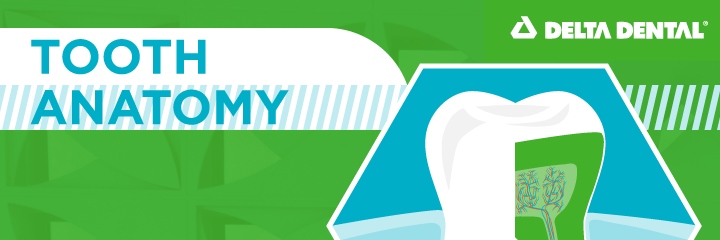Tooth enamel is the hardest substance a vertebrate – or an animal with a backbone – has in its body. It’s harder than bone! So, what is enamel? And, if it’s the hardest substance we have, how does enamel erosion occur?
WHAT IS TOOTH ENAMEL?
Specific types of fish have enamel on their teeth, like we do, but they also have it on their scales. Scientists have recently discovered that the teeth and scales share similar genetic makeup. Researchers used genetic studies to conclude that fish scales may be the original source of tooth enamel.
Let’s take a step back and review the whole tooth. A tooth is mostly made up of the crown, the top white part you can see, and the root, which is what you can’t see. The other things making up the tooth are tissues. There are four different kinds, one of which is enamel.

Enamel covers the crown of the tooth. It protects it from the wear and tear we inflict on our teeth every day. “Dentin,” another type of tissue, sits underneath the enamel. It’s a softer layer that acts like a shock-absorber for our enamel. When we bite down, the dentin absorbs that pressure. But, if we bite down on something we’re not supposed to, or if we have poor dental health, this may not work correctly. If that’s the case, it’s possible for the enamel layer on the outside to crack or fracture.
Enamel is made up almost entirely of minerals. They make up 96 percent of the tooth. It has more minerals than anywhere else in the body. The rest of a tooth is organic material and water. Because enamel doesn’t contain any living cells, it cannot repair itself. This is why only a dentist can fix damaged enamel.
HOW DOES ENAMEL EROSION OR DAMAGE TO TOOTH ENAMEL OCCUR?
An injury can damage our enamel, but foods, drinks, and what we put in our mouths can also cause damage. Acidic substances wear away the enamel on our teeth the fastest. Did you know that sugar isn’t exactly what gives us cavities? Sugar turns into an acidic substance after the bacteria in our mouth consume it, and that’s what causes cavities. That’s why when we eat and drink sweet things, it can cause cavities if we don’t properly brush and floss afterwards.
Foods and beverages are considered acidic with a pH of 4.6 or lower. A few highly acidic drinks include
- lemon juice (2.5 pH),
- soda (avg pH of 3.2),
- cocktail juice (avg pH of 2.8),
- sports drinks, (avg pH of 3.3),
- flavored teas (avg pH of 3.5).
Plain water is considered “basic,” or the opposite of acidic. It can actually rinse away the acid that sits on our teeth after we drink beverages that are acidic.
Acid reflux is also a condition that commonly impacts tooth enamel. People with acid reflux aren’t always able to keep their stomach acid from rising into their mouth. Its highly erosive nature can wear away tooth enamel when it comes in contact with the teeth. A dentist can often see this in their patients, as the erosion often occurs on the inside surfaces of the teeth, as well as the chewing surfaces.
If you do experience acid reflux, remember to rinse with water instead of brushing immediately after you experience reflux. Because of its highly acidic nature, brushing the teeth when they have stomach acid on them can actually brush away and erode your enamel. That’s why it’s better to immediately rinse with water and wait at least half an hour before brushing. This is also true after consuming acidic beverages.
Wondering if your enamel has eroded? Here are some common signs that you could have enamel erosion:
- Pain or sensitivity when consuming drinks that are hot, cold or sweet,
- Yellowish discoloration of the teeth,
- Your dentist notices you have an increased risk for cavities over time.
In extreme cases, enamel erosion can lead to a tooth abscess, or even tooth loss. When we see our dentist regularly over time, he or she can monitor any changes occurring in our mouth and take action to prevent things like an abscess or tooth loss from occurring.


